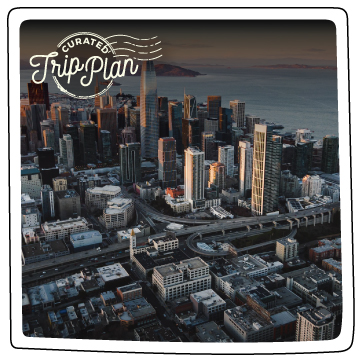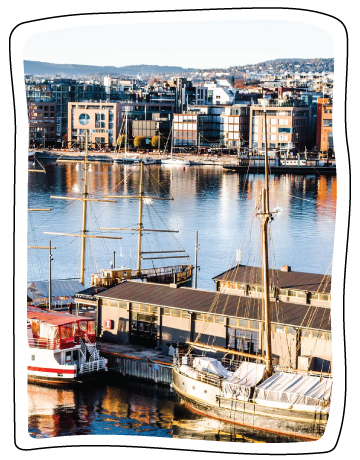Friendly disclaimer! We want to be as accurate as possible, but given these challenging times, we urge you to recheck that the venues are open when you decide to travel.
While most tourists pass off Oslo as a gateway destination to the rest of Norway, we think otherwise. For starters, this beautiful city located between the Oslo Fjord and the expansive Oslomarka forest was awarded the European Green Capital 2019. Its commitment to conserve its nature reserves and forests, covering half of its area was a major reason. However you wish to explore the wonders of this city – by hiking, cycling, fishing, and skiing or swimming, one cannot help but be inspired. It’s a city that puts people and nature first, quite literally. So here’s our list of the best places in Oslo to immerse yourself in.
Tjuvholmen City beach
Start your day with a refreshing swim smack in the city center. The Tjuvholmen beach is located at the end of Aker Brygge boardwalk and pier. It also has a huge lawn, is picture-perfect and ripe for sunbathing. The lawn is in fact a sculpture park of the Astrup Fearnley Museum .This beach is especially popular during the summer months among children. In winter, parts of the water freezes, but this doesn’t seem to be a deterrent for eager ice bathers!
Akker Brygge boardwalk also hosts many top-notch restaurants and cafes with stunning views over the water. To reach take any T-bane line to “Nationaltheatret”, bus to “Rådhuset”, or tram to Aker Brygge. Walk along Aker Brygge towards the water and the museum lawns.

Botanical Garden
This is Norway’s oldest and largest botanical garden with over 5,500 plant types. Located in the neighbourhood of Tøyen, it is managed by the University of Oslo. The plants are also used for research, education and conservation awareness on the importance of plant diversity. It is also a haven for endangered Norwegian plants and trees.
There are many different thematically planned gardens here some of which are: The Scent Garden full of fragrant varieties that particularly benefit the visually challenged and specially-abled; The Viking Garden which exhibits the traditional Viking way of using plants, animals and rocks; The Systematic Garden with plants arranged according to their species; The great-granny’s garden hosts species that are no more obtainable commercially, The Willow Sculptures features beautifully wrought willow rods by artist Tom Hare.To reach here one can catch the metro to Tøyen station, tram to Lakkegataskole or bus to Munch-Museet, Lakkegataskole or Toyenskole.
Unravelog tip: The children’s activity area around Klimahuset (Natural History Museum) has numerous trees that are great to climb and offer respite from the summer heat.

Ekeberg
If you’ve heard of Edvard Munch’s painting, “The Scream” then you’d like to know the Ekberg neighbourhood in Oslo is where he painted it. This locale has much to be famous for – the 25.5-acre Ekebergparken sculpture and national heritage park here is considered as one of the world’s five best sculpture parks. Ekberg is also rich in geological history – Norway lies in a region that was formerly covered by ice sheets, circa 8500 BC. Ekberg is one of the oldest settlements, on the highest points of the land, which rose up after the ice receded.
The park is a great place for learning and experiencing this history along with nature, stunning views, and art by international artists. Don’t miss exploring some remains of Oslo history here, from stone age rock carvings and ruins to cemeteries dating from 900-400 BC. A white villa hosts the Ekebergparken Museum and shop that can be spotted when turning off Kongsveien toward Ekebergparken. One could also join guided tours conducted in the summer as well as book private tours.
Unravelog tip: Make sure you wear good shoes and are fit enough to walk its vast expanse consisting of dense woods, mountainous regions, valleys and walking trails. Also, download a detailed map from the website to not miss the best parts!

Oslofjord
The word fjord in English means ‘a long, narrow, deep inlet of the sea between high cliffs, as in Norway, typically formed by submergence of a glaciated valley’. In Norwegian however, it’s also used to define a much wider network of waterways.
The Oslofjord too is vast, unlike most others. Formed by an inlet of the Skagerrak Sea, it extends from Oslo city to the Torbjørnskjær and Færder lighthouses. While the narrower northern area is the inner Oslofjord, the south is called the Outer Oslofjord. While it’s not as beautiful as other Norwegian fjords that are 100s of miles away from Oslo, this is by far the most accessible and budget-friendly. To reach, jump on a public ferry at Akker Brygge near central Oslo. There are private cruise options as well as floating saunas that are all the rage now – with many varieties of rafts to choose from like Green Boats!
As for the islands of the fjord, there are many options depending on the time you’d want to spend. Some of these are:
Hovedøya- This is the closest island, taking just five minutes by ferry to reach. The sunny beaches here are very popular in summer. A 12th-century Cistercian monastery known as Hovedøya Abbey is also worth a visit. There’s a cafe next to it that serves pizza, beer, ice-cream, pølser (popular Danish pork sausage), etc during summer.
Håøya- If you’d want to stay overnight consider Håøya, the largest island, about an hour away. One could walk the forested trails, hike up the hill and enjoy views over the stunning bay. Don’t miss the café cum bakery, Håøya Naturverksted, that has fresh goat cheese on offer.
Oscarsborg- This should be a mandatory stop for history buffs, for its grand 19th-century fortress. The island is set at a narrow fork point of the fjord, which in the past, made it apt to set up defence structures. The fort is now a splendid hotel and resort and is still a popular attraction. Besides this, the fort frequently hosts summer concerts and gigs here.

If you are thrilled exploring Oslo’s urban forests and have more time in hand to spend discovering the city in detail, check out our detailed itinerary that unravels Oslo in 3 days.






